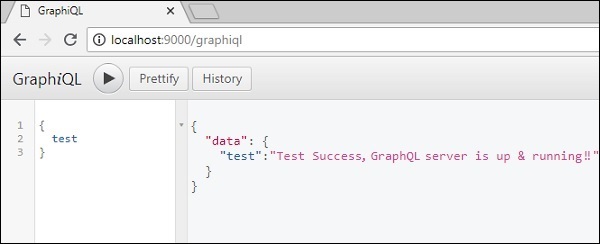
- GraphQL 教程
- GraphQL - 首頁
- GraphQL - 簡介
- GraphQL - 環境設定
- GraphQL - 架構
- GraphQL - 應用程式元件
- GraphQL - 示例
- GraphQL - 型別系統
- GraphQL - 模式
- GraphQL - 解析器
- GraphQL - 查詢
- GraphQL - 變異
- GraphQL - 驗證
- GraphQL - JQuery 整合
- GraphQL - React 整合
- GraphQL - Apollo Client
- GraphQL - 客戶端身份驗證
- GraphQL - 快取
- GraphQL 有用資源
- GraphQL - 快速指南
- GraphQL - 有用資源
- GraphQL - 討論
GraphQL - 環境設定
在本章中,我們將學習 GraphQL 的環境設定。要執行本教程中的示例,您需要以下內容:
執行 Linux、macOS 或 Windows 的計算機。
一個網路瀏覽器,最好是最新版本的 Google Chrome。
已安裝的最新版本的 Node.js。建議使用最新的 LTS 版本。
已安裝 GraphQL for VSCode 擴充套件的 Visual Studio Code 或您選擇的任何程式碼編輯器。
如何使用 Nodejs 構建 GraphQL 伺服器
我們將逐步詳細介紹如何使用 Nodejs 構建 GraphQL 伺服器,如下所示:
步驟 1 - 驗證 Node 和 Npm 版本
安裝 NodeJs 後,使用以下命令在終端上驗證 node 和 npm 的版本:
C:\Users\Admin>node -v v8.11.3 C:\Users\Admin>npm -v 5.6.0
步驟 2 - 建立專案資料夾並在 VSCode 中開啟
專案的根資料夾可以命名為 test-app。
使用以下說明使用 Visual Studio Code 編輯器開啟資料夾:
C:\Users\Admin>mkdir test-app C:\Users\Admin>cd test-app C:\Users\Admin\test-app>code.
步驟 3 - 建立 package.json 並安裝依賴項
建立一個 package.json 檔案,其中將包含 GraphQL 伺服器應用程式的所有依賴項。
{
"name": "hello-world-server",
"private": true,
"scripts": {
"start": "nodemon --ignore data/ server.js"
},
"dependencies": {
"apollo-server-express": "^1.4.0",
"body-parser": "^1.18.3",
"cors": "^2.8.4",
"express": "^4.16.3",
"graphql": "^0.13.2",
"graphql-tools": "^3.1.1"
},
"devDependencies": {
"nodemon": "1.17.1"
}
}
使用以下命令安裝依賴項:
C:\Users\Admin\test-app>npm install
步驟 4 - 在 Data 資料夾中建立平面檔案資料庫
在此步驟中,我們使用平面檔案來儲存和檢索資料。建立一個名為 data 的資料夾,並新增兩個檔案 **students.json** 和 **colleges.json**。
以下是 **colleges.json** 檔案:
[
{
"id": "col-101",
"name": "AMU",
"location": "Uttar Pradesh",
"rating":5.0
},
{
"id": "col-102",
"name": "CUSAT",
"location": "Kerala",
"rating":4.5
}
]
以下是 **students.json** 檔案:
[
{
"id": "S1001",
"firstName":"Mohtashim",
"lastName":"Mohammad",
"email": "mohtashim.mohammad@tutorialpoint.org",
"password": "pass123",
"collegeId": "col-102"
},
{
"id": "S1002",
"email": "kannan.sudhakaran@tutorialpoint.org",
"firstName":"Kannan",
"lastName":"Sudhakaran",
"password": "pass123",
"collegeId": "col-101"
},
{
"id": "S1003",
"email": "kiran.panigrahi@tutorialpoint.org",
"firstName":"Kiran",
"lastName":"Panigrahi",
"password": "pass123",
"collegeId": "col-101"
}
]
步驟 5 - 建立資料訪問層
我們需要建立一個數據儲存,用於載入資料資料夾的內容。在這種情況下,我們需要集合變數 students 和 colleges。每當應用程式需要資料時,它都會使用這些集合變數。
在專案資料夾中建立檔案 db.js,如下所示:
const { DataStore } = require('notarealdb');
const store = new DataStore('./data');
module.exports = {
students:store.collection('students'),
colleges:store.collection('colleges')
};
步驟 6 - 建立模式檔案 schema.graphql
在當前專案資料夾中建立一個模式檔案,並新增以下內容:
type Query {
test: String
}
步驟 7 - 建立解析器檔案 resolvers.js
在當前專案資料夾中建立一個解析器檔案,並新增以下內容:
const Query = {
test: () => 'Test Success, GraphQL server is up & running !!'
}
module.exports = {Query}
步驟 8 - 建立 Server.js 並配置 GraphQL
建立一個伺服器檔案並配置 GraphQL,如下所示:
const bodyParser = require('body-parser');
const cors = require('cors');
const express = require('express');
const db = require('./db');
const port = process.env.PORT || 9000;
const app = express();
const fs = require('fs')
const typeDefs = fs.readFileSync('./schema.graphql',{encoding:'utf-8'})
const resolvers = require('./resolvers')
const {makeExecutableSchema} = require('graphql-tools')
const schema = makeExecutableSchema({typeDefs, resolvers})
app.use(cors(), bodyParser.json());
const {graphiqlExpress,graphqlExpress} = require('apollo-server-express')
app.use('/graphql',graphqlExpress({schema}))
app.use('/graphiql',graphiqlExpress({endpointURL:'/graphql'}))
app.listen(
port, () => console.info(
`Server started on port ${port}`
)
);
步驟 9 - 執行應用程式並使用 GraphiQL 測試
驗證專案 test-app 的資料夾結構,如下所示:
test-app /
-->package.json
-->db.js
-->data
students.json
colleges.json
-->resolvers.js
-->schema.graphql
-->server.js
執行命令 npm start,如下所示:
C:\Users\Admin\test-app>npm start
伺服器在 9000 埠執行,因此我們可以使用 GraphiQL 工具測試應用程式。開啟瀏覽器並輸入 URL https://:9000/graphiql。在編輯器中鍵入以下查詢:
{
Test
}
伺服器返回的響應如下所示:
{
"data": {
"test": "Test Success, GraphQL server is running !!"
}
}
